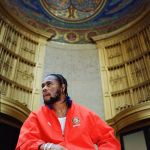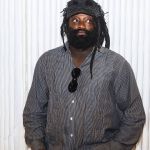
What’s next for Supreme?
The post-streetwear era has arrived

September 29th, 2022
In 1994, a scruffy British lad by the name of James Jebbia spent 12,000 of his finest United States Dollars to open his very first Supreme store. Situated on Lafayette Street in Lower Manhattan, the location was encapsulated within a humble, stark black exterior with large single-glazed windows to the left and right-hand sides. A simple white door acts as the entrance to the space, and right in the middle, a bold red box logo features the word “Supreme” written in a heavy, italicized font. While the Barbara Kruger-inspired brand mark would remain exactly the same over the next 28 years, little did anyone know, everything else would be completely different.
There’s no doubt that Supreme was, and still is, one of the most renowned clothing brands in the world, to the point that even your grandma’s grandma probably knows about it. With that said, it’s clear to see that hypebeasts and streetwear lovers just aren’t buying it anymore - both literally and figuratively. A few years ago, every single drop would sell out instantly, but nowadays, items would sit on the webstore for weeks or even months on end. When VF Corporation acquired 100% of Supreme two years ago, everyone quietly knew that it was no longer the cult label that it once was, making us ask the question, “What’s next?” As of this moment, VF Corporation owns 13 brands in total, including The North Face and Vans. Over the years, both of these companies have collaborated with Supreme countless times, so it should come as no surprise that it would fall under the same umbrella. What this means is that you’ll probably see more and more collections drop over the next few years to keep up with demand. While this may make the streetwear label-less hyped in the long run, that isn’t necessarily a bad thing. TNF and Vans are still both extremely sought-after and they were acquired in 2000 and 2004, respectively. Perhaps having VF’s hand on the steering wheel could guide Supreme to fresh, new pastures. Investors were spooked to see VF's shares drop 6.9 per cent to $32.66 last Wednesday, but after divesting Lee and Wrangler jeans in 2019 and acquiring Supreme in a $2.1 billion deal in 2020, the group is still settling in. «We are committed to continually shaping this company, we are deeply committed to growth» - CEO Steven E. Rendle told BOF.
While this may sound detrimental to diehard Sup enthusiasts, making fashion more accessible is almost always a good thing. Take Kanye West’s adidas partnership, for example. In 2015, Ye made the bold statement on Ryan Seacrest’s radio show that «Eventually everybody who wants to get Yeezys will get Yeezys.» Fast forward to today, and his shoes are no longer as limited as they used to be. Sneakerheads don’t have to sell their kidneys for a pair of 350 V2s, and they certainly don’t have to queue outside in the pouring rain for hours just to buy them. It’s worth remembering that even though the brand has six stores in Asia, all of these are located in Japan. This means that it’s almost impossible for Asian fans outside of Japan to buy their favorite pieces without having to pay resale prices. With VF Corp’s help, more and more shops can open in countries like China, India, Malaysia, and the Philippines. While you might be worried that you’ll soon be able to buy Supreme in places such as ASOS and Urban Outfitters, Jebbia still has full creative control, so Supreme pieces will only be available at Supreme. That’s the plan for now, anyway.
While this is probably the most likely scenario for Supreme, you simply can’t ignore the fact that the streetwear landscape has changed drastically over the past five years. Supreme was probably at its peak in terms of hype in 2017. With the launch of its ultra-limited Louis Vuitton collaboration and exclusive pieces like the Nas T-shirt, people were absolutely obsessed with the brand back then. With that said, even if you truly wanted to buy some of these pieces, it was virtually impossible for you to acquire them without using bots or shelling out extortionate amounts. In fact, in the UK, the Nas Tee sold out in just 18 seconds, with the majority of these hitting resale platforms like StockX and Grailed minutes later. Fans were absolutely furious over this, and it’s moments like these that have ushered in what is now being coined a “post-streetwear” world. When asked what he thinks will happen to the idea of streetwear in 2020, the late and great Virgil Abloh simply said, «Wow. I would definitely say it’s gonna die, you know? Like, it’s time will be up. In my mind, how many more t-shirts can we own, how many more hoodies, how many sneakers?» This comment almost immediately caused a bout of mass hysteria amongst the community, because not only did we not agree with it, we secretly did too. At this point in time, the idea of streetwear had already spun off into multiple genres. Dadcore kicked everything off around 2018 when the fashion world fully embraced flannels and chunky sneakers, and this worked in tandem with normcore, which applied a sense of simplicity to everything.
In 2019, Clogcore quickly made its way into our wardrobes due to the COVID-19 pandemic, and when we were finally allowed out of our homes, Gorpcore took the industry by storm. Suddenly, everyone who wore Supreme half a decade ago was now decked out in nothing but Arc'teryx, Patagonia, and Salomon. None of this fell in line with the New York City-based brand’s style, and by the time streetwear fans started getting back into the skate aesthetic in 2020 with the rise of Nike SB, it was far too late. To put this into perspective, as part of its Fall/Winter 2020 drop, it released another graphic-heavy collection that looked far too similar to pieces from three years prior. Hypebeasts worldwide was bored of this, and to add fuel to the fire, Supreme teamed up with luxury watch company Jacob & Co. for a timepiece collection that started from $14,000, which was far beyond reach for 99.9% of its customer base. It became painstakingly clear that the James Jebbia-helmed company wasn’t listening, and so things needed to change fast. Very fast.
Earlier this year, Supreme named Tremaine Emory its new Creative Director. The founder of Denim Tears, which has been approved by industry juggernauts such as Ye and ASAP Nast, he also worked with Marc Jacobs for nine years, before becoming Director-at-Large for Stüssy. Over the past decade, the Atlanta-born and Queens-raised creative has collated quite a roster of collaborations, including but not limited to Champion, Levi’s, New Balance, and of course, Off-White™. These are all some of post-streetwear’s biggest and most popular brands, so Supreme wanting him to lead the charge should come as no surprise to anyone. Back in August, Tremaine took to Instagram to announce that he was bringing back PYREX VISION. One of Virgil Abloh’s passion projects from 2011, was controversial because Abloh essentially purchased blanks from Ralph Lauren for $40, screen-printed designs on them, and sold them for prices upwards of $600. If Emory can make hypebeasts excited about this, think about what he’ll be able to achieve with one of the industry’s most storied and iconic labels.
Since Angelo Baque stepped down as Brand Director in 2017, Supreme has relied heavily on bold and brash graphics and logos to sell its pieces. With Emory’s guidance, however, we’ll begin to see more meaningful collections that have a proper, well-defined narrative. «The world kinda doesn’t need more clothes. So, I think clothes should have some type of meaning, a reason why,» he told Complex in a 2022 interview. «I’ll never run out of stories. There’s an infinite well of stuff to talk about. And that’s any culture. Whatever culture you’re from, if you decide to make movies, or clothing, or write a book, or whatever, there’s an infinite amount.» The post-post-streetwear era is coming in hot, and in this dynasty, Tremaine Emory will reign Supreme.





















































